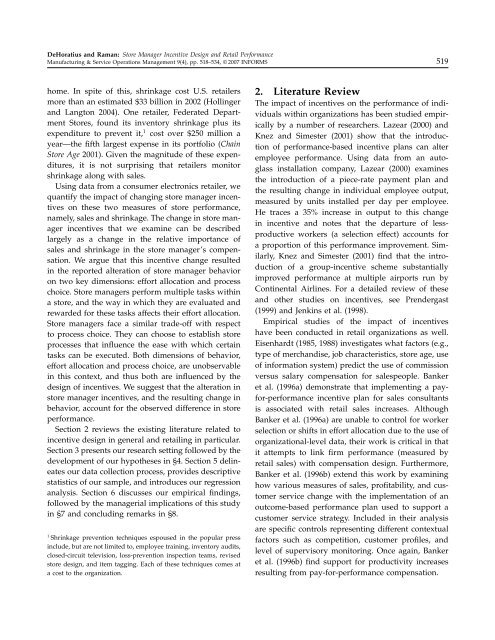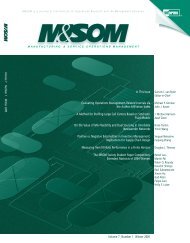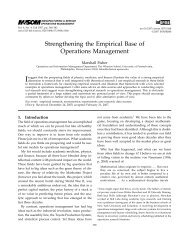Store Manager Incentive Design and Retail Performance: An ...
Store Manager Incentive Design and Retail Performance: An ...
Store Manager Incentive Design and Retail Performance: An ...
Create successful ePaper yourself
Turn your PDF publications into a flip-book with our unique Google optimized e-Paper software.
DeHoratius <strong>and</strong> Raman: <strong>Store</strong> <strong>Manager</strong> <strong>Incentive</strong> <strong>Design</strong> <strong>and</strong> <strong>Retail</strong> <strong>Performance</strong><br />
Manufacturing & Service Operations Management 9(4), pp. 518–534, © 2007 INFORMS 519<br />
home. In spite of this, shrinkage cost U.S. retailers<br />
more than an estimated $33 billion in 2002 (Hollinger<br />
<strong>and</strong> Langton 2004). One retailer, Federated Department<br />
<strong>Store</strong>s, found its inventory shrinkage plus its<br />
expenditure to prevent it, 1 cost over$250 million a<br />
year—the fifth largest expense in its portfolio (Chain<br />
<strong>Store</strong> Age 2001). Given the magnitude of these expenditures,<br />
it is not surprising that retailers monitor<br />
shrinkage along with sales.<br />
Using data from a consumer electronics retailer, we<br />
quantify the impact of changing store manager incentives<br />
on these two measures of store performance,<br />
namely, sales <strong>and</strong> shrinkage. The change in store managerincentives<br />
that we examine can be described<br />
largely as a change in the relative importance of<br />
sales <strong>and</strong> shrinkage in the store manager’s compensation.<br />
We argue that this incentive change resulted<br />
in the reported alteration of store manager behavior<br />
on two key dimensions: effort allocation <strong>and</strong> process<br />
choice. <strong>Store</strong> managers perform multiple tasks within<br />
a store, <strong>and</strong> the way in which they are evaluated <strong>and</strong><br />
rewarded for these tasks affects their effort allocation.<br />
<strong>Store</strong> managers face a similar trade-off with respect<br />
to process choice. They can choose to establish store<br />
processes that influence the ease with which certain<br />
tasks can be executed. Both dimensions of behavior,<br />
effort allocation <strong>and</strong> process choice, are unobservable<br />
in this context, <strong>and</strong> thus both are influenced by the<br />
design of incentives. We suggest that the alteration in<br />
store manager incentives, <strong>and</strong> the resulting change in<br />
behavior, account for the observed difference in store<br />
performance.<br />
Section 2 reviews the existing literature related to<br />
incentive design in general <strong>and</strong> retailing in particular.<br />
Section 3 presents our research setting followed by the<br />
development of ourhypotheses in §4. Section 5 delineates<br />
our data collection process, provides descriptive<br />
statistics of our sample, <strong>and</strong> introduces our regression<br />
analysis. Section 6 discusses ourempirical findings,<br />
followed by the managerial implications of this study<br />
in §7 <strong>and</strong> concluding remarks in §8.<br />
1 Shrinkage prevention techniques espoused in the popular press<br />
include, but are not limited to, employee training, inventory audits,<br />
closed-circuit television, loss-prevention inspection teams, revised<br />
store design, <strong>and</strong> item tagging. Each of these techniques comes at<br />
a cost to the organization.<br />
2. Literature Review<br />
The impact of incentives on the performance of individuals<br />
within organizations has been studied empirically<br />
by a number of researchers. Lazear (2000) <strong>and</strong><br />
Knez <strong>and</strong> Simester(2001) show that the introduction<br />
of performance-based incentive plans can alter<br />
employee performance. Using data from an autoglass<br />
installation company, Lazear(2000) examines<br />
the introduction of a piece-rate payment plan <strong>and</strong><br />
the resulting change in individual employee output,<br />
measured by units installed perday peremployee.<br />
He traces a 35% increase in output to this change<br />
in incentive <strong>and</strong> notes that the departure of lessproductive<br />
workers (a selection effect) accounts for<br />
a proportion of this performance improvement. Similarly,<br />
Knez <strong>and</strong> Simester (2001) find that the introduction<br />
of a group-incentive scheme substantially<br />
improved performance at multiple airports run by<br />
Continental Airlines. For a detailed review of these<br />
<strong>and</strong> other studies on incentives, see Prendergast<br />
(1999) <strong>and</strong> Jenkins et al. (1998).<br />
Empirical studies of the impact of incentives<br />
have been conducted in retail organizations as well.<br />
Eisenhardt (1985, 1988) investigates what factors (e.g.,<br />
type of merch<strong>and</strong>ise, job characteristics, store age, use<br />
of information system) predict the use of commission<br />
versus salary compensation for salespeople. Banker<br />
et al. (1996a) demonstrate that implementing a payfor-performance<br />
incentive plan for sales consultants<br />
is associated with retail sales increases. Although<br />
Banker et al. (1996a) are unable to control for worker<br />
selection orshifts in effort allocation due to the use of<br />
organizational-level data, their work is critical in that<br />
it attempts to link firm performance (measured by<br />
retail sales) with compensation design. Furthermore,<br />
Bankeret al. (1996b) extend this work by examining<br />
how various measures of sales, profitability, <strong>and</strong> customerservice<br />
change with the implementation of an<br />
outcome-based performance plan used to support a<br />
customer service strategy. Included in their analysis<br />
are specific controls representing different contextual<br />
factors such as competition, customer profiles, <strong>and</strong><br />
level of supervisory monitoring. Once again, Banker<br />
et al. (1996b) find support for productivity increases<br />
resulting from pay-for-performance compensation.




